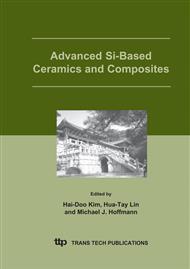[1]
T.S. Gonczy, R. Goettler and S. Wansom, Tensile Testing of Oxide Ceramic Fibers in Single Filament and Multifilament Tow Configurations, Ceram. Eng. Sci. Proc., 21, 549-557 (2000).
DOI: 10.1002/9780470294628.ch64
Google Scholar
[2]
Y. Hirata, T. Maeda and T. Ono, Impregnation and Pyrolysis of Polytitanocarbosilane in an Si-Ti-C-O Fabric / Mullite Porous Composite and Tensile Strength of the Densified Composite, 0 50 100 150 200 250 0 50 100 150 200 Calculated strength / MPa Measured strength / MPa Fig. 3 Relationship between the measured and calculated strengths ( Eq. (2) in text ) of the laminated composites of 35-40 vol% Si-Ti-C-O fabric, 15-25 vol% mullite filler and 18-26 vol% PTC- derived solid and 1. 8-24 vol% porosity. The straight line represents the calculated strength / measured strength ratio = 1. J. Ceram. Proc. Res., 3, 241-246 (2000).
Google Scholar
[3]
Y. Hirata, T. Matura and K. Hayata, Infiltration and Pyrolysis of Polytitanocarbosilane in an Si-Ti-C-O Fabrics / Mullite Porous Composite, J. Am. Ceram. Soc., 83, 1044-1048 (2000).
DOI: 10.1111/j.1151-2916.2000.tb01328.x
Google Scholar
[4]
D.M. Wilson, Statistical Tensile Strength of Nextel 610 and Nextel 720 Fibers, J. Mater. Sci., 32, 2535-2542 (1997).
Google Scholar
[5]
S.M. Toffoli and R.L. Lehman, Determination of Individual Fiber Failure in Fiber Bundle, J. Am. Ceram. Soc., 84, 123-128 (2001).
Google Scholar
[6]
P.A. Siemers, R.L. Mehan and M.H. Moran, A Comparison of the Uniaxial Tensile and Pure Bending Strength of Silicon Carbide Filaments, J. Mater. Sci., 23, 1329-1333 (1988).
DOI: 10.1007/bf01154597
Google Scholar
[7]
T. Yamamura, T. Ishikawa, M. Shibuya and K. Okamura, Development of a New Continuous Si-Ti-C-O Fiber Using an Organometllic Polymer Precursor, J. Mater. Sci., 23, 2589-2594 (1988).
DOI: 10.1007/bf01111919
Google Scholar
[8]
Y. Hirata and K. Takeshima, Effects of Particle Classificarion on Colloidal Processing of Mullite, Mater. Lett., 16, 169-174 (1993).
DOI: 10.1016/0167-577x(93)90157-s
Google Scholar
[9]
J. Sugimoto, Y. Hirata and M. Shibuya, Tensile Strength and Weibull Modulus of the Si-Ti-C-O Fiber Yarn and Woven Fabric, J. Ceram. Soc. Japan, Suppl. 112, S385-S389 (2004).
Google Scholar
[10]
T. Ono, M. Kaji and Y. Hirata, Fracture Behavior of Si-Ti-C-O Fiber / Mullite Matrix Composites Under Anticlastic Bending Test, J. Ceram. Soc. Japan, 106, 1147-1150 (1998).
DOI: 10.2109/jcersj.106.1147
Google Scholar
[11]
T. Ono, Y. Kyoden and Y. Hirata, Influence of Fabric Node of Filament Yarn on the Fracture of Si-Ti-C-O Fiber / Mullite Laminate Composites Under Anticlastic Bending Test, J. Ceram. Soc. Japan, 108, 424-427 (2000).
DOI: 10.2109/jcersj.108.1256_424
Google Scholar


